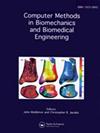利用基因表达数据进行癌症预测的改进量子扩展卷积神经网络。
IF 1.7
4区 医学
Q3 COMPUTER SCIENCE, INTERDISCIPLINARY APPLICATIONS
Computer Methods in Biomechanics and Biomedical Engineering
Pub Date : 2025-05-20
DOI:10.1080/10255842.2025.2502816
引用次数: 0
摘要
本文提出了一种改进的量子扩展卷积神经网络(QDCNN),利用基因表达数据检测癌症。首先,输入的基因表达数据是从指定的数据集中获取的。然后,使用自适应Box-Cox变换进行数据转换,并使用Kulczynski深度神经网络(DNN)进行特征融合。这些改进后的特征被输入到改进后的QDCNN中,从而有效地预测癌症。改进后的QDCNN在使用PANCAN数据集时,准确率为90.6%,真阳性率(TPR)为89.0%,假阴性率(FNR)为0.109,马修斯相关系数(MCC)为89.9%。本文章由计算机程序翻译,如有差异,请以英文原文为准。
Modified quantum dilated convolutional neural network for cancer prediction using gene expression data.
This paper proposes a modified Quantum Dilated Convolutional neural network (QDCNN) to detect cancer using gene expression data. Primarily, the input gene expression data is taken from a specified dataset. Then, data transformation is done using Adaptive Box-Cox transformation and feature fusion is done by a Deep Neural Network (DNN) with Kulczynski. The refined features are then fed into the modified QDCNN, which effectively predicts cancer. The modified QDCNN attains an accuracy of 90.6%, a True Positive Rate (TPR) of 89.0%, False Negative Rate (FNR) of 0.109, and a Matthews correlation coefficient (MCC) of 89.9% when using the PANCAN dataset.
求助全文
通过发布文献求助,成功后即可免费获取论文全文。
去求助
来源期刊
CiteScore
4.10
自引率
6.20%
发文量
179
审稿时长
4-8 weeks
期刊介绍:
The primary aims of Computer Methods in Biomechanics and Biomedical Engineering are to provide a means of communicating the advances being made in the areas of biomechanics and biomedical engineering and to stimulate interest in the continually emerging computer based technologies which are being applied in these multidisciplinary subjects. Computer Methods in Biomechanics and Biomedical Engineering will also provide a focus for the importance of integrating the disciplines of engineering with medical technology and clinical expertise. Such integration will have a major impact on health care in the future.

 求助内容:
求助内容: 应助结果提醒方式:
应助结果提醒方式:


